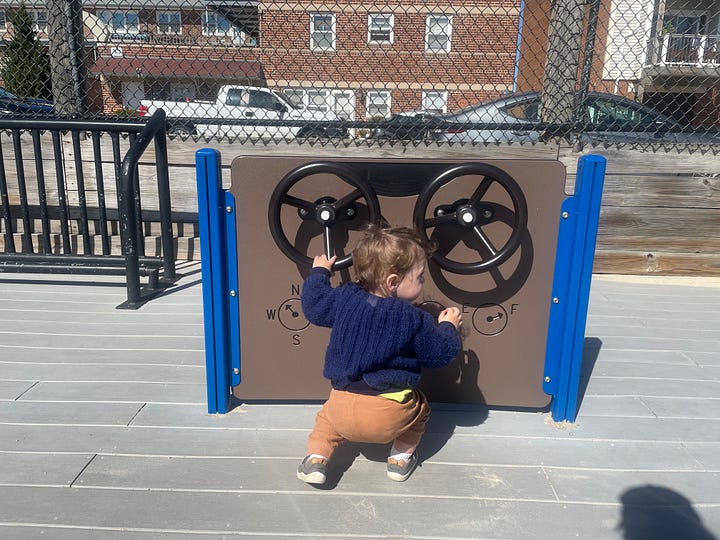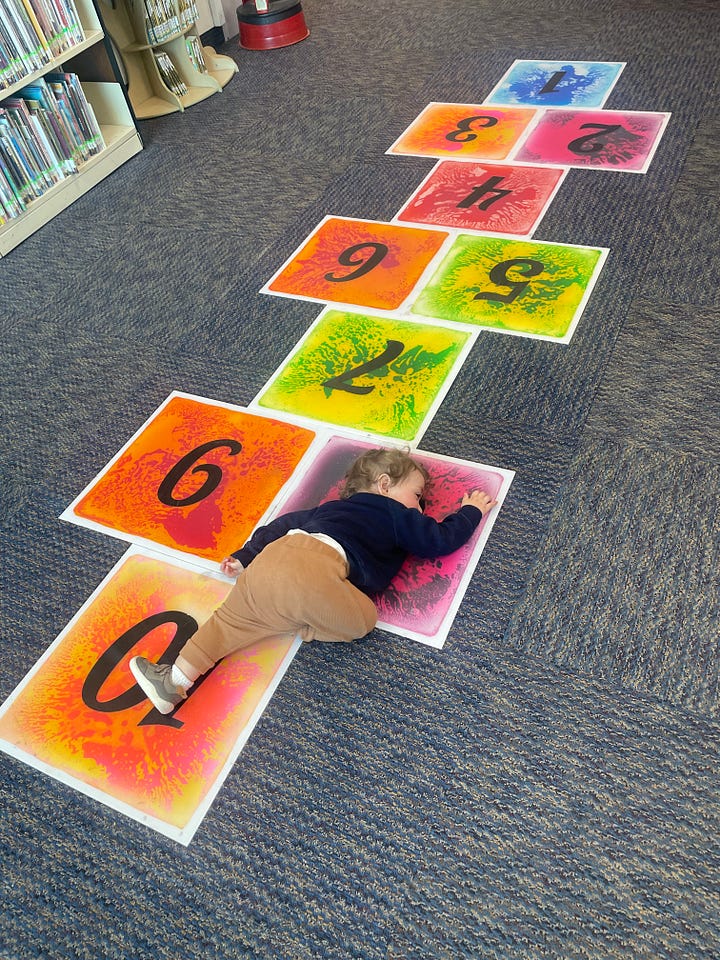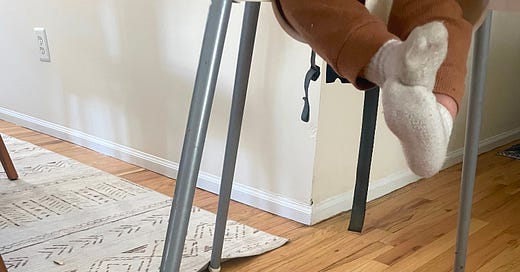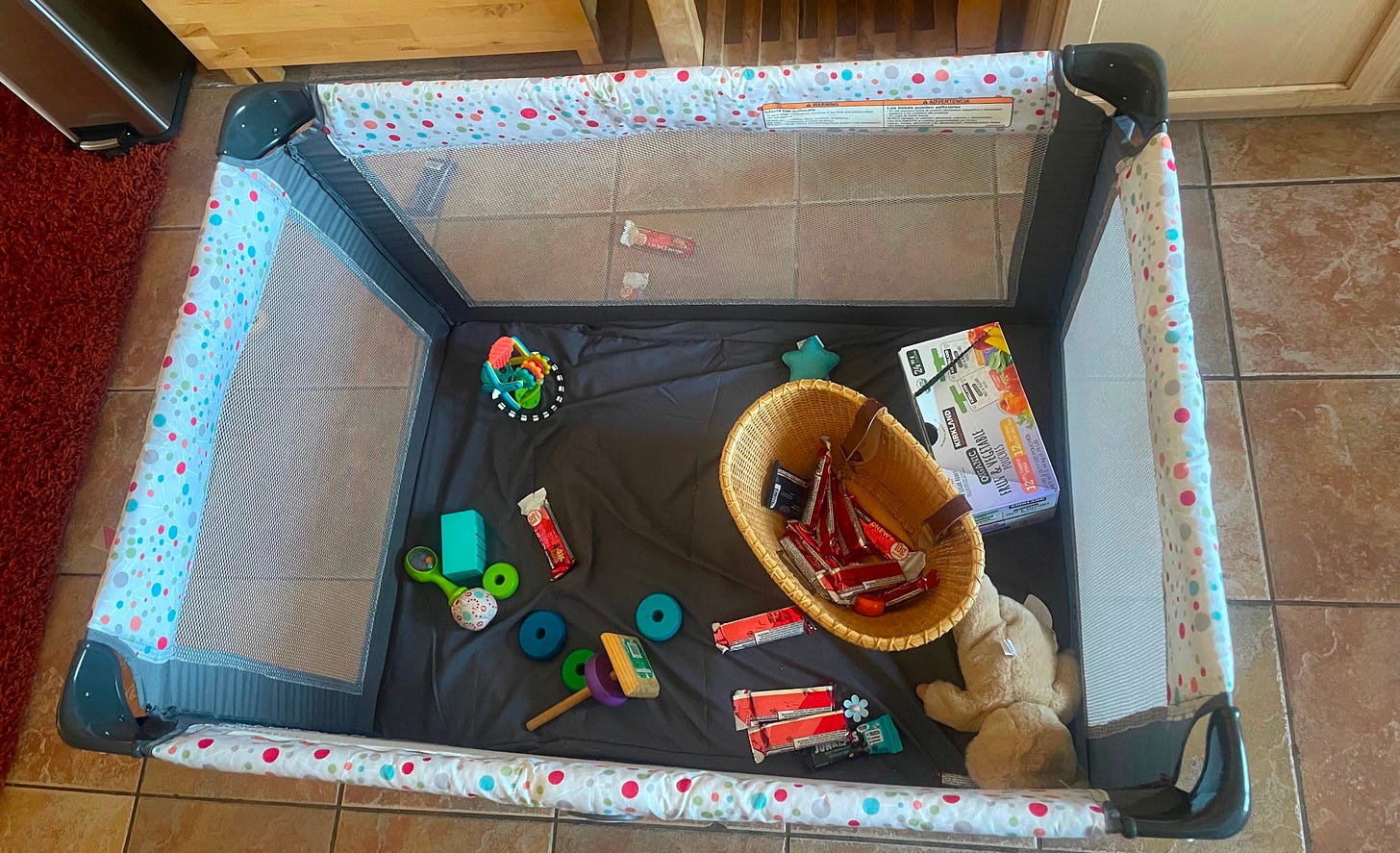Schemas, Routines, & Finding Meaning in Transitions
See Also: Why Is There Always Yogurt On My Floor??
The baby—who, I suppose, is something closer to a babytoddler now?—is gleefully throwing shiny red-foil-wrapped granola bars over the top of his pack ’n’ play as I type this. One after another, over they go. Bonk. Clack. Clunk.
It’s his current favorite game: throwing, dropping, watching objects fall. From the perch of his highchair goes his toys, his food, his spoons, his forks. Over and over, with the dedication of a tiny scientist. He is working hard, updating his schema.
What’s a Schema?
Schemas are the mental frameworks we use to understand the world—our internal blueprints, constantly revised as we gather new information. It’s something I learned about in grad school, and have now witnessed in the play of countless young children.
For toddlers, schemas are built through action and repetition, trial and error. It’s why hands-on play is the top echelon of play. The act of physically manipulating an object and figuring out ~how it all works~ here on planet Earth—there is just no richer ground.
Take my babytoddler in his high chair, for example, conducting his daily physics experiments with his breakfast (and lunch… and dinner…).
He’s thinking, in his babytoddler way: Okay, so what happens when I drop this blueberry? What sound does it make? How long does it take to hit the floor? Does it roll or splat? Now, what about my Cheerios? Or hey, how about my entire bowl of yogurt? Ooooh, that last one made Mommy say, “Oh, babyyy, what a mess!” Let’s do it again!
Every tossed bowl of yogurt, every block tower knocked over, every object turned upside down or hidden under a blanket—it’s all part of the experiment.
Once you can start seeing your kid’s actions through the lens of schemas, toddlerhood becomes wildly fascinating.
Some common schemas include:
Trajectory – Exploring movement. Think: Dropping food from the high chair, splashing water in the bath, swinging high on the playground.
Enveloping – Experimenting with covering or wrapping objects. Blankets over baby dolls, climbing into Amazon boxes or kitchen cabinets, burying items (or themselves!).
Connection – Figuring out how things join and separate. Clicking train cars together, building (and immediately knocking down) block towers, holding hands in Ring Around the Rosie, magnets and zippers and glue.
Transporting – Moving objects from one place to another. Bringing rocks from the park into the house, filling a tote bag with toys and carrying it across the room.
Enclosing – Creating boundaries. Forts, fences, and fairy-tale-castles made out of wooden blocks.
Other common schemas: Orientation, Rotation, Positioning


Schemas are one of my favorite early childhood nuggets. It’s like a parenting party trick: “Oh, he’s deep in his enveloping schema—see how he tucks all his toys under the blanket?” or “That’s the enclosing schema—she’s building a fence around her stuffed animals!”
Understanding schemas makes everyday toddler chaos feel more purposeful. They’re not just making messes for fun (okay, maybe a little fun)—they’re constantly testing, experimenting, and working through big ideas about cause and effect, gravity, balance, matter, and energy, one sensory mess at a time.
And here’s the key: Once you recognize a schema in action, you can lean into it and offer a safe (or a less destructive) way for them to explore. Instead of constantly saying “No throwing!” (or at least in addition to constantly saying no throwing), you can redirect to a chosen activity that explores the same concept.
Since the baby loves to drop things, I set him up in his pack ’n’ play with a Costco-sized box of granola bars and let him go wild. It’s far preferable to picking up a bowl of red-sauce pasta off the floor, thank you very much.
Now, when your kiddo’s urge to transport kicks in, and they begin hauling literally all six thousand of their stuffed animals from their bedroom into your newly-cleaned living room, you can at least know their little scientist brain is hard at work. And then you can give them a tote bag to help them ~transport schema~ it all back to their room.
Adults Have Schemas, Too
Toddlers aren’t the only ones constantly revising their mental frameworks—adults do it all the time, too.
Think about commuting to work. At first, you might be completely overwhelmed, checking GPS, second-guessing turns, re-reading street signs, feeling disoriented. But after a few days, you start to recognize landmarks. You remember which subway car is best for exiting quickly, and figure out which streets have the worst traffic at what times.
That’s a schema. You’re always refining your mental map, making sense of the patterns, adjusting your expectations.
Then one day, construction starts at your usual exit. Your schema no longer works. You’re thrown off, recalculating—maybe you get off at a different stop, or leave ten minutes earlier the next day to compensate. You’ve updated your schema.
We do this all the time as adults. We learn the unspoken rules of a new workplace, figure out which grocery store checkout line moves fastest, adapt to a new phone layout, tweak our last-coffee-of-the-day time if we can’t fall asleep at night, rearrange our furniture so we stop bonking our knee on the table. We shift, we change, we adjust.
Lately, I feel like I’m in the middle of a major schema update.
I’m figuring out my new rhythm—in my new town, now that the weather isn’t completely miserable, and now that the baby isn’t entirely a baby anymore. Every day still looks a little different. Some mornings, I commute to Brooklyn to teach my baby/toddler/caregiver classes. Other days, it’s just me and the ever-more-wild babytoddler, navigating our way through the day, trying to find some kind of flow.
What even is our daily rhythm now? Where do we go? What do we do all day?
The weather always plays a starring role—if it’s warm and sunny, we’ll be outside as much as we can. But what about all of these cold, drizzly, in-between days? What’s the plan then?
What do I do with myself during nap time? Wait—when is nap time again? Is he consolidating from two naps to one? Oh, nope, never mind—he was just teething!
There’s always shifting data as the baby grows, as the weather changes, as my own needs and plans and goals begin to take shape.
Just like my son, I’m experimenting, tossing things over the edge and seeing what sticks.
And slowly, little pieces of structure are starting to emerge—tiny anchors in the upheaval. Maybe they’ll hold. Maybe they won’t. But for now, they’re forming the framework of my days. Until the next update, at least!
Here are some things I’m doing right now that seem to be helping—
Reading a book, first thing in the morning. Ohh, how much better my mornings (and therefore my days) are when I start with a book rather than a scroll. Even if I only get through a page or two, it’s a grounding, calming way to start. It reminds me: this is something I enjoy, and it’s a priority to me. I also feel like no matter how hectic or scattered my day gets, I already did something I love.
Recent morning-time reads: The Wedding People by Alison Espach, Liars by Sarah Manguso, We All Want Impossible Things by Catherine Newman.
The longest walk I can, as close to daily as possible. Long walks have always been my favorite, but I’m figuring out when and where and how works best. Early morning after school drop-off? Mid-afternoon stroller nap? Maybe even in the evening, alone? Do I stick to the same route or mix it up? What Little Free Libraries or tiny coffee shop treats can I find along the way? (Treats are v important to long walks!)
Observe the ocean every day. I’m making it a point to really see it—the way the waves shift from ferocious to flat overnight, how the sky mutates in color, how the beach feels different depending on the hour, the wind, the tide. I try to notice the variations in soundscape, bird activity, the shells and sea glass, the texture of the sand. (And guys, there’s this moment—the one when I’m walking up the ramp to the boardwalk, when in a single step I go from not seeing to seeing—and it’s like a little hit of nature crack. Every time, I audibly gasp: Oh my god. I hope it never gets old.)



Pictures never do it justice Screen habits:
Leaving my phone in its designated charging spot, as often as possible. Treating it like a landline, as best I can!
When possible, use the bigger screen. If I can send an email or check the news or waste time on pop culture Reddits from my iPad or laptop instead of my phone, I do. It makes me feel less hunched and scattered, and less prone to time-suck distraction. I don’t know why it works, but it does!
One-screen-at-a-time time. Listen, some television is made to be on in the background, and that’s fine—but some television is not, and I’m finding it satisfying to be clear about which is which. Temptation Island on Netflix is pure trash and perfect for ambient viewing while folding laundry. It’s okay (and maybe even preferred) to not pay too close attention. But The White Lotus? That’s one-screen time. I am LOCKED IN to this season, and I think it’s partly because I’m actually focused on it and nothing else. (Piper, noooooooo!)
The simplest dinners, as early as possible. This is not the time of my life for elaborate meals. It’s also not the time for nightly family-of-four dinners at 6 p.m.—that happens maybe twice a week, if we’re lucky! Instead, I’ve been making peanut butter oatmeal, blueberry pancakes, black bean quesadillas, macaroni and cheese, or a simple pasta and veg for the kids at 4:30 p.m. after the big kid gets home from school. He’s starving anyway—why not let him eat a meal then? He can snack the rest of the night away! And then, the evening isn’t so crowded, so rushed, so pressured, which is a much better vibe for all.
Bedtime reading with the big kid. I don’t know if other families do it this way, but during the baby’s first year, we leaned hard into divide-and-conquer: my husband took the big kid out on adventures while I stayed home, cozy with the baby. It worked for us, but the big kid used to be my baby too—and I would miss him! So I’ve always tried to hold onto our bedtime cuddle-and-read routine as much as possible. It’s one of my favorite parts of the day—favorite parts of my life?!—just me, him, and a good, long chapter book. After we read for 30ish minutes, we cuddle, and he tells me little nuggets about his day and his friends—his adorably astute observations, his wild ideas, and his sneaky seven-year-old schemes. What could be a better way to end the night than that?
Swimming laps. Something about the repetitive back-and-forth, the muted sound, the focus on breath, the weightlessness, the gliding through water, the way I feel afterward—buzzed and calm. I’m aiming for twice a week, with a quick meditation in the steam room afterward. Can I keep it up?? I hope so! So far, so good.
For now, these are my tiny anchors, the little patterns I’m building into my days. Maybe they’ll last, maybe they won’t. Maybe the schemas will continue to be updated and altered as new information comes in, but right now, they’re helping me make sense of things.
I’d love to know—what’s helping you find calm in your rhythm and routine these days?
PS: As I put the finishing touches on this post, the babytoddler was beside me, happily opening and shutting the kitchen garbage can. Kinda gross, kid! But hey—that’s the enveloping schema in action, so... good job? See how that works?!
Thanks, as always, for reading!










This was SO good SO helpful 😍😍
I really enjoyed this Danielle. It’s funny I clicked in thinking you might be talking about schema therapy — but was happy to learn about these kinds of schema! Such a good party trick 😂 your list was also soothing — can confirm I too feel much better not looking at the phone first thing, and doing my best to get a good walk in each day as well. Thanks for sharing!